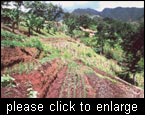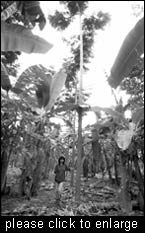InfoResources News No 4 / 04 (September
2004)
Special feature
> An integrated understanding of land as a
resource
Of current interest
Policy
> Food production requires more and more water
> Biological diversity: Insurance against
future famines
> Living with the risk
Implementation
> An objective view of urban agriculture
in Africa
> ‘Golden rules’ for mountain protected
areas
> Difficult search for alternatives to drug
cultivation
Research
> Bridging the gap between farmers and policy-makers:
A difficult task
> Social change in the forest communities
of Asia
> The forest – an income generator to combat
rural poverty
Our Readers’ Survey
> Our readers demand high quality
information
An integrated understanding of land as a resource
 The
ongoing discussions on diminishing water resources have somewhat pushed
soil and land use issues to the background. However, today nearly 2
billion hectares of land are affected by human-induced degradation processes,
putting the livelihoods of more than one billion people at risk (UN
Millennium Development Declaration). The
ongoing discussions on diminishing water resources have somewhat pushed
soil and land use issues to the background. However, today nearly 2
billion hectares of land are affected by human-induced degradation processes,
putting the livelihoods of more than one billion people at risk (UN
Millennium Development Declaration).
Unsustainable resource and environmental policies, poorly defined land rights, pressure from urbanisation, primarily production-oriented land
use and agricultural intensification, often coupled with a rising demand
for land, accelerate the loss of fertile soils. Land degradation causes
considerable changes in the productive and regulative cycles of ecosystems.
While poverty can aggravate land degradation, it is also a consequence
of diminishing land resources.
In the light of this situation, the United Nations Environment Programme
UNEP) is intensifying its efforts to combat soil and land degradation
in a new Strategy on Land Use Management and Soil Conservation. This
strategy takes an integrated functional approach and focuses on the
promotion of sustainable policies that foster equitable socio-economic
development and emphasise both the productive and the regulative role
that soil plays in ecosystems. This integrated ecosystem approach interlinks
the management of land, water, and living resources towards a sustainable
productive land use. The UNEP strategy formulates key areas for future
activities. The following issues are particularly interesting:
• Interconnections between sustainable land use and multinational
agreements within and outside UN organisations on water, biodiversity,
and other issues need to be given more consideration.
• The UNEP strategy supports the development of environmental policies
that integrate innovative land use strategies. This often requires transparent
and participatory institutional restructuring, for example by merging
various areas of responsibility or redefining task fields. Instruments
and guidelines are needed in order to achieve this and a transparent
information policy is promoted, combined with awareness
raising on all levels.
• The UNEP acknowledges the identification and economic valuation of
services provided by soil ecosystems to be a pivotal aspect in innovative
economic policies.
• Partnerships with civil society shall be strengthened in order to
integrate
civil society into the dialogue and foster its competences. Local knowledge
and experience are important elements in adapting and prioritising innovative
land use strategies on the local, national and regional levels.
Another comprehensive study from Uganda illustrates the complexity of
developing policies and strategies on poverty reduction and promoting
sustainable land use on both the national and the local level. While
population pressure and expansion of agricultural production accelerate
soil erosion, several factors, such as a higher education, livestock
farming, and non-agricultural income, can help reduce the loss of soil
nutrients. In this respect, the different situations and potentials
of women and men are an important aspect – something that is not sufficiently
considered in the UNEP strategy. The Uganda study emphasises that ”win-win-win”
solutions combining an increase in agricultural production and income
with a reduction of land degradation hardly exist. The responsibility
for an integrated approach is assigned to the NGOs, while the importance
of national policies taking a guiding role is left unmentioned.
Sources:
> UNEP’s Strategy on Land Use Management and Soil Conservation,
A Strengthened Functional Approach. UNEP Policy Series 4, 2004. 63p.
www.unep.org/pdf/UNEP-strategy-land-soil-03-2004.pdf
> Strategies for Sustainable Land Management and Poverty Reduction
in Uganda. Ephraim Nkonya et al. IFPRI, Research Report 133. 2004.
www.ifpri.org/pubs/pubs.htm#rreport

Of current interest: Policy
Food production requires more and more water
 Around
70% of all water resources in human use flow into agriculture. The production
of 1 kg of cereals, for example, requires between 500 and 3000 litres
of water. Current production patterns are often unsustainable and inflict
lasting damage on aquatic ecosystems. The demand for water may continue
to grow: efforts to increase global food security, and, thus, agricultural
production, as well as a trend towards more water-consuming foods such
as meat, make this seem quite probable. Around
70% of all water resources in human use flow into agriculture. The production
of 1 kg of cereals, for example, requires between 500 and 3000 litres
of water. Current production patterns are often unsustainable and inflict
lasting damage on aquatic ecosystems. The demand for water may continue
to grow: efforts to increase global food security, and, thus, agricultural
production, as well as a trend towards more water-consuming foods such
as meat, make this seem quite probable.
The quoted report locates a need for action on different levels in order
to secure sustainable global water use: water productivity must be increased
and the necessary technology made available; consumption patterns need
to be influenced towards a healthy diet and moderate water consumption;
aquatic ecosystems need adequate protection; agricultural subsidies
and trade barriers that impede trade in water-saving foods must be abolished.
An interesting aspect of the report is the important role it attributes
to consumption trends in the global water issue. At the same time, it
points out that food production is more and more demand-oriented. However,
the question of how consumption patterns might be redirected onto a more
sustainable track is left unanswered.
Source: Water – More Nutrition per Drop.
Towards Sustainable Food Production and Consumption Patterns in a Rapidly
Changing World. Stockholm International Water Institute (SIWI) and International
Water
Management Institute (IWMI), New York, April 2004. 36 p.
www.siwi.org/downloads/More_Nutrition_Per_Drop.pdf
Biological diversity: Insurance against future famines
The FAO estimates that over the past century around 75% of the genetic
diversity of agricultural crops has been lost. Today, the world population’s
food supply is based on few productive varieties of a limited number
of crop plants. This narrow genetic range makes global agriculture prone
to epidemics and negative effects of climate change.
This year’s World Food Day on 16 October will therefore be dedicated
to biological diversity as an insurance against future famines. This
thematic focus will also provide the FAO with an opportunity to showcase
”its” International Treaty on Plant Genetic Resources, which came into
force on 29 June.
This treaty acknowledges the great contribution farmers make to sustaining
genetic diversity, and thus strengthens farmers’ rights. Part of the
agreement regulates a multilateral system that secures access to genetic
resources for researchers and breeders, while a share of the production
profit is also allocated to the guardians of biodiversity, i.e. to farmers
in the South. The intentions embodied in the treaty are welcomed by
all parties concerned. However, the interpretation of the treaty text
by farmer organisations and agro-industry representatives differs substantially
with regard to intellectual property rights. The treaty’s implementation
will no doubt lead to controversial discussions.
Source: Biodiversity for food security.
FAO launches campaign in favour
of biodiversity – World Food Day/ TeleFood 2004. FAO News. Rome, 20
May 2004. 2p. www.fao.org/newsroom/en/news/2004/42621/index.html
Living with the risk
In 1999 the UN Decade on Natural Disaster Reduction came to a disappointing
close: natural hazards were causing more human suffering and higher
economic losses than ten years earlier. Analysts speak of further increasing
”risk burdens” due to myriads of wrong development decisions through
all levels from the local to the international. In the light of this
disillusioning assessment, the UN is calling a World Conference on Disaster
Reduction in 2005 in Kobe, Japan. Furthermore, the UN-Secretariat of
the International Strategy for Disaster Reduction (ISDR) has completely
revised its successful report entitled Living with Risk: A global review
of disaster reduction initiatives, which was first published in 2002.
The new edition, published in 2004, no longer aims solely at sensitising
people with regard to possible catastrophic effects of natural hazards;
it places more emphasis on the fact that a majority of natural hazards
are caused by human activities.
The report supports politicians, implementation-oriented institutions,
and other interested individuals in preventing natural hazards or mitigating
their negative impacts. This is done with a view to more careful planning
and improved regulation mechanisms. The strength of this report lies in
its practice- oriented content, its wealth of details, and its nonetheless
clear structure. Online extracts of the report already provide a good
insight into the issue.
Sources:
> Living with Risk: A global review of disaster reduction
initiatives. 2004 Version. Vol. I: 454 pp, Vol. II (Annexes): 130 pp.
ISDR, Geneva, 2004. www.unisdr.org/eng/about_isdr/bd-lwr-2004-eng.htm
> World Conference on Disaster Reduction, 18–22 January 2005, Kobe,
Hyogo, Japan. www.unisdr.org/wcdr/

Of current interest: Implementation
An objective view of urban agriculture in Africa
This publication, edited by the International Development Research
Centre (IDRC), International Cooperation Centre on Agronomical Research for
Development (CIRAD) and the Senegalese Agricultural Research Institute
(ISRA), capitalises on their experiences of urban agriculture in Africa.
It presents diagnostic and intervention approaches to deal with the
processes at work in urban agriculture, its place in urban planning,
vegetable and animal production chains, and its contribution to the
recycling of urban waste.
In Africa, vegetable growing tends to be the most common form of urban
agriculture – an activity that is best suited to provide food, employment
and income. Chapter 3 contains a thorough production chain analysis
which explains the link between the demand for vegetable products and
existing marketing channels. The contextual study of production and
its restrictions (access to land and input) and the motivations behind
it (self-sufficiency in food, quick returns) also considers the social
role of vegetable growing and sets out the different types of farming
involved. Finally, access to seeds and water, the use of genetic resources,
and an advice service are put forward as ways to improve vegetable production
in Africa.
Source: Développement durable
de l’agriculture urbaine en Afrique francophone : enjeux, concepts et
méthodes. Ed. Olanrewaju B.
Smith… [et al.]. CIRAD/IDRC, 2004. 176 p.
http://web.idrc.ca/en/ev-52181-201-1-DO_TOPIC.html
‘Golden rules’ for mountain protected areas
 In 2002, over 4.6 million km2 of mountainous terrain – slightly more
than 10% of the total mountain area – were under protection, and the
number of protected areas is still on the increase. Poor accessibility,
a great disadvantage for economic development, proves an asset when
it comes to preserving biodiversity and natural or man-made landscapes.
Half of the world’s 24 biodiversity hotspots are located in mountainous
areas. In the past, protected areas were defined and managed in a dirigiste
manner by central government agencies. Today it is widely acknowledged
that protection regulations need to be elaborated together with the
local population in a way that leaves room for adequate, controlled
development. This publication offers a comprehensive framework for the
design and management of protected areas. Innumerable recommendations
are summarised in so-called ‘golden rules’:
In 2002, over 4.6 million km2 of mountainous terrain – slightly more
than 10% of the total mountain area – were under protection, and the
number of protected areas is still on the increase. Poor accessibility,
a great disadvantage for economic development, proves an asset when
it comes to preserving biodiversity and natural or man-made landscapes.
Half of the world’s 24 biodiversity hotspots are located in mountainous
areas. In the past, protected areas were defined and managed in a dirigiste
manner by central government agencies. Today it is widely acknowledged
that protection regulations need to be elaborated together with the
local population in a way that leaves room for adequate, controlled
development. This publication offers a comprehensive framework for the
design and management of protected areas. Innumerable recommendations
are summarised in so-called ‘golden rules’:
• Understand the region’s ecology
• Understand the local people’s culture
• Understand the nature of physical, biological, cultural and socio-economic
changes
• Secure participation of the local population and a wide circle of
stakeholders in planning, management and decision-making
The Guidelines can serve those interested as a valuable checklist. However,
the list provides little help when it comes to establishing concrete
planning and implementation processes.
Source: Guidelines for Planning and Managing
Mountain Protected Areas.
Lawrence Hamilton and Linda McMillan (eds.) 2004. IUCN World Commission
on Protected Areas. 92p. www.iucn.org/info_and_news/press/mountainPAguide.pdf
For further reading: Information
on the UNESCO World Natural Heritage Site Jungfrau- Aletsch-Bietschhorn:
www.nccr-north-south.unibe.ch/
Objectives.asp?contextID=9&refTitle=Swiss%20Alps&Context=JACS
Difficult search for alternatives to drug cultivation
 For
many years, thirty-five thousand Bolivian farmers relied on illegal
coca cultivation to secure their livelihood. The construction of a sawmill
in the midst of Bolivia’s tropical lowlands in 1997 marked the launching
of an FAO project designed to reduce dependency on coca cultivation
by partly replacing it with sustainable use of forests for timber production. For
many years, thirty-five thousand Bolivian farmers relied on illegal
coca cultivation to secure their livelihood. The construction of a sawmill
in the midst of Bolivia’s tropical lowlands in 1997 marked the launching
of an FAO project designed to reduce dependency on coca cultivation
by partly replacing it with sustainable use of forests for timber production.
Earlier, coca farmers cultivated rice for their own subsistence, slashing
and burning the forest to clear the required space. The project manager
pointed out to them that in order to clear the space required to grow
a rice crop worth USD 300, they were destroying USD 3000 worth of timber.
This convinced the farmers to begin using the forest for timber production
in a sustainable manner. However, the shift from coca growing to timber
trade reduced their salaries from USD 2000 to USD 900 per year. Additional
cultivation of various crops, such as rubber, coffee, cocoa, camu camu,
and achiote are now hoped to help improve the income.
Similarly to these activities in Bolivia, the FAO is trying to support
poppy farmers in Afghanistan in their shift from drug cultivation to
growing alternative crops. Improved education, infrastructure and access
to credits will help foster fruit and vegetable cultivation, the growing
of niche cultures, such as spices or mulberries for silk, as well as
essential oil production and chicken farms.
Sources:
> Offering Bolivian coca growers legal alternatives. FAO News.
January 2004. 3p. www.fao.org/newsroom/en/field/2004/35907/index.html
> Alternatives for the Transformation of Drug Production Areas in
Bolivia – Results from the Region Chapare for Farming Systems (Abstract).
Juan Carlos Torrico, et al. Deutscher Tropentag. Göttingen, October
2003. 1p.
www.tropentag.de/2003/abstracts/links/Torrico_reW87Hjf.php
> Poppy cultivation in Afghanistan – the search for alternatives.
FAO News. February 2004. 2p. www.fao.org/newsroom/en/news/2004/36107/

Of current interest: Research
Bridging the gap between farmers and policy-makers: A difficult task
How can farmers’ needs and concerns be integrated into development
policy decisions? The quoted report contains an analysis of three large
African farmers’ institutions and their background. These institutions
differ clearly in their orientations: Two of them are closely linked
to the government and support programmes in favour of a market-oriented
economy, while the third is independent from the government and, as
an independent advocacy organisation, demands efforts to improve rural
livelihoods. Furthermore, one organisation focuses more on counselling,
while the others emphasise their role as a representative of members’
interests.
Nevertheless, the report gives several recommendations that are applicable
to all institutions: to improve the staff’s educational level, as well
as information exchange within the given organisation; to strengthen
the farmers’ attachment to their organisation through annual fees and
the right to elect representatives; to define the leaders’ responsibilities
towards the grass-roots members more clearly; and to improve the coordination
and communication between the two. Furthermore, the authors recommend
that financial dependency on foreign development organisations be reduced
and openness for the farmers’ interests among government workers be
promoted.
Source: A Comparative Review
of Multistakeholder Arrangements for
Representing Farmers in Agricultural Development Programmes and Policy-making
in Sub-Saharan Africa. Jim Bingen. Michigan State University. For FAO.
Rome, April 2004. 41p. www.fao.org/sd/dim_in3/docs/in3_040501d1_en.doc
Social change in the forest communities of Asia
The distinguishing feature of ”Gender relations in forest societies
in Asia” is that it combines the history of and myths surrounding forest
communities with an examination of the current situation of this population
group. Using country case studies (China, India, Malaysia and Thailand),
this publication explores the advances and regressions in the role of
women in these societies, their struggles and external influences at
work.
For example, since 1980, the issue of the right of access to the forest
at the local level in Uttarakhand (India, Himalayas) has been driven
by the global ideology of environmental conservation. Consequently,
the regional forestry department of Uttar Pradesh, through a World Bank
project, promotes village forest joint management (VFJM), taking its
inspiration from a model based on the traditional idea that control
of and access to forest resources belong to the men. However, alongside
this process, a mixed form of informal village forest joint management
has also developed. It is supported by women’s groups who have demanded
and received recognition within their own family or community.
This work is of interest to anyone who is active in village forest joint
management. This type of management is crucial in combating poverty
insofar as it implies the involvement of women in the process at the
social, economic and political levels.
Source: Gender relations in forest societies
in Asia: patriarchy at odds. Ed. by Govind Kelkar, Dev Nathan, Pierre
Walter. New Delhi, Sage, 2003. 325 p. https://www.vedamsbooks.com/no33839.htm
The forest – an income generator to combat rural poverty
The most disadvantaged populations often depend on income from non-cultivated
natural resources for their survival. Basing their research on many
small-scale experiences, the authors develop this point insofar as they
attempt to capture the importance of this income, define it as well
as quantify it in the relevant context.
The findings of the analysis are presented in Chapter 4 by means of
hypothesis testing and several tables accompanied by extensive commentaries
(comparison of income by economic sector and by source, consideration
of external domestic factors, diversification of income sources, geographical
area and the type of forest). The authors conclude that the income generated
by forest resources represents an average contribution to household
income of 22% in the populations sampled, with the main sources being
firewood, wild foods and animal fodder.
These findings will be useful for programmes to combat poverty and to
conserve natural resources. However, it should be noted that due to
the wealth of variables given and the economic analysis per se, this
study might be somewhat inaccessible to the non-economist.
Source: Counting on the environment.
Paul Vedeld… [et al.]. Washington,
World Bank, 2004. XV, 95 p.
http://lnweb18.worldbank.org/essd/envext.nsf/44ByDocName/
CountingontheEnvironmentForestIncomesandtheRuralPoor 2004/$FILE/CountingontheEnvironmentForestIncomesand
theRuralPoor.pdf

Our Readers’ Survey
Our readers demand high quality information
The information needs expressed by users of InfoResources News and
Focus are strongly centred around transdisciplinary topics, such as
sustainable land management. Above all, users are interested in how
these topics can be implemented in strategies and projects. This is
the result of a user survey commissioned by InfoResources. The users
were asked about their information needs and their assessment of various
information products. We thank all those who participated and thus help
us to improve.
The survey showed that users demand high quality information. They want
to find very concretestatements in both publications and prefer that
these
statements be assessed whenever possible. In general, both InfoResources
News and InfoResources Focus have received highly positive feedback:
• The frequency of publication was assessed ’just right’ by 75% of the
users for InfoResources News and for 66% of the users for InfoResources
Focus.
• The layout and structure of both the Newsletter and Focus also finds
a very high level of agreement.
• A surprising and highly positive outcome of the survey is the high
degree of intense readers: 27% of them read the entire publications,
and another 42% read individual articles entirely.
• Another pleasing result is the high percentage of users who make active
use of the information they obtained from InfoResources publications.
Half of the users click on links, download documents, or use ideas in
conferences.
Based on these results, we will keep our products in their current form.
However, the contents will be more strongly oriented towards the needs
expressed by our users.

|




